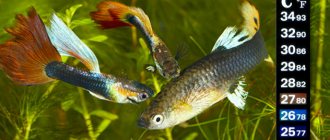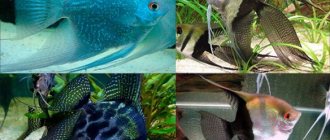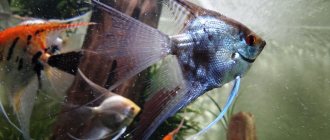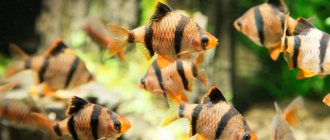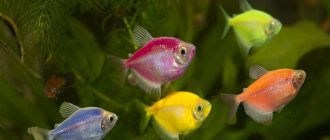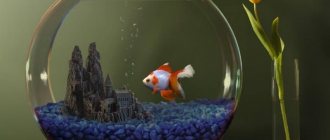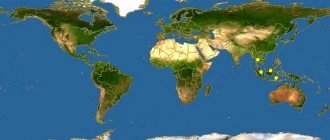Habitat in nature
The galaxy fish lives in Burma on the high Shan plateau, which rises more than a kilometer above the level of the world ocean. The habitat of this species is very small and is limited to the basins of the Nam Lan and Nam Paun rivers and nearby small lakes and ponds, replenished with water from spring floods. Tiny reservoirs are located in sunlit expanses, so they are quickly overgrown with typical aquarium plants - elodea and blixa. The water in the lakes native to microrasbora, the depth of which does not exceed thirty centimeters, is very clean.
Until now, the water parameters in these reservoirs have been poorly studied, so it becomes unclear how to maintain the galaxy at home. Few scientific reports report that the water in these lakes of Burma is soft and neutral.
Compatibility with other types of fish
Small pearl fish are peaceful and harmless. The content of micro-analysis of the galaxy is not provided in conjunction with aggressive and large neighbors. Neighbors of the same small size are ideal for their collective habitat:
- cuneiform rasboras;
- neons;
- guppy;
- cardinals;
- cherry barbs.
It has been noticed that when the listed species are added to an aquarium, zebrafish stop hiding and begin to swim throughout the water space, forming a school with other fish. In addition, you should not put shrimp and Galaxies in the same aquarium. The fact is that pearl beauties eat small shrimp, the adults of which feed on microrasbora eggs.
Appearance
The fish is very small - the length of adult individuals does not exceed 22-23 millimeters. This species belongs to the carp family, and therefore has a similar smooth, streamlined body shape. The caudal fin is solid, not divided into lobes. The dorsal fin is “neat” and has the shape of a smoothed scalene triangle. The anal fin is large and identical to the dorsal fin. The eyes are large and bright yellow. Galaxies are variegated, and the color of an individual strongly depends on gender. The fish live for two to three years.
Sex differences
Males are colored deep blue with distinctive white and cream spots. The fins have bright red and black stripes. Females are noticeably paler - they have a blue-green color, the spots are more yellowish, not as contrasting as those of males. The stripes on the fins are more orange than red. Females are larger than males and have a more rounded abdomen and smooth body contours.
Appearance of fry
If the microrasbora galaxy is well maintained, reproduction is carried out all year round; for this purpose, different females and males are selected. After spawning, adult individuals are transplanted into the main aquarium for restoration. When keeping male and female fish separately before spawning, the number of eggs laid increases to 50. Three days later, dark-colored larvae emerge from them, the size of which is 0.8 mm. After two days, it turns into a full-fledged silver fry, which immediately begins to feed on live food. It is noted that Galaxies do not eat their own eggs and larvae. But the swimming fry is perceived as food and can be eaten. But if there is a lot of live food in the aquarium, then the adults do not attack the fry.
Behavior and character
Very peaceful and harmless fish. An amazing feature was noticed: living in a species aquarium, the galaxy becomes shy, keeps in flocks near the day or in the middle layers of water. In a general aquarium, this species feels more confident, especially if it is adjacent to calm bottom-dwelling fish, for example, small catfish.
The behavior of Danio Margaritatus (which used to be called Celestichthys Margaritatus) is very interesting. The brightest dominant males are rivals, but rarely injure each other when entering into conflict - more often they limit themselves to ritual fights. They can also chase females and low-ranking males, but everything is done with the usual warnings and intimidation. In small tanks the fish become more aggressive, and in some cases strong males have severely injured weaker ones.
One of the mistakes that breeders make is to keep rasboras in large flocks. In this case, males will spend a lot of time fighting. Therefore, it is better to have a small flock of four to five individuals in a large aquarium, ideally one male and a harem of three to four females.
Compatibility with other types
They get along well with peaceful small fish. The rasbora galaxy is a very small fish, so most species can attack it and try to eat it.
Compatible types are:
- neons;
- Endler's guppies;
- zebrafish;
- cherry and Denison barbs;
- cuneiform rasbora;
- Mollynesia;
- Ramirez apistogram;
- veiled herbivorous fish.
The galaxy also gets along well with arthropods, especially peaceful and small shrimp.
It is very dangerous to keep a rasbor with large predators, for example, astronus and cichlids, which can eat even relatively large angelfish.
Incompatible species are:
- all large Cichlids;
- koi carp;
- astonothus;
- piranha and pacu;
- cockerels;
- tetradons;
- large catfish;
- arowanas;
- swordtails.
It is better not to take risks and avoid breeding with restless species, for example, Sumatran and shark barbs or relatively large laliuses and gouramis. The latter are considered relatively compatible and will only get along if they were placed in a common aquarium as fry.
Compatibility
The fish are shy; if they notice movements behind the glass, they hide in the thickets. When adjacent to other inhabitants they become bolder.
Microassembly Galaxy is friendly. She will easily get along with other small representatives (zebrafish, rasbora, guppies, cockerels), with large non-aggressive fish that live in the bottom layer of the aquarium, with shrimp or snails.
Mostly males court females and swim around them to gain favor. They also start fights, usually without causing damage. But if there is a dominant among the males, he can harm his rivals with his sharp teeth. You can distinguish it from others by the integrity of its fins; in the rest they will be torn.
If the aquarist plans to further breed these individuals, it is preferable to keep them separately. Then spawning will take place without jigging directly in the tank.
Content
Water parameters
The conditions of the liquid environment are the most important parameters on which not only the health, but also the life of small pets often depends.
Temperature
The fish is incredibly resistant to temperature changes and can live in different conditions - it is a so-called eurythermal species. This may be due to the harsh living conditions in the highlands. The water temperature can range from 19 to 28 °C. However, warm water is more suitable for reproduction - 24-26 °C.
Rigidity
Fish prefer softer water. Unlike many other species, rasbora feels comfortable even in very soft water, almost not saturated with salts and dissolved organic matter. In an aquarium, you can maintain a water hardness of 2-15 dH units.
Acidity
The species has not yet been sufficiently studied, so there are no strict criteria for selecting water acidity. Many aquarists claim that the galaxy lives in very wide acidity ranges, the main thing is that the water is clean. Absolutely neutral water with pH = 7 is considered ideal. If temperature deviations are taken into account and errors are taken into account, it can be considered a neutral environment for an aquarium when the pH value is from 6.7 to 7.3.
Substrate and vegetation
Any type of soil is suitable. You can use sand of any granular size, pebbles, pebbles or small gravel. It is possible to use decorative types of substrate, for example, coconut fibers. The dark color of the soil favorably emphasizes the variegated color of the galaxy.
Animals feel comfortable in an aquarium densely planted with plants. All species should be present: large floating ones, low shrubs and soft grass carpets covering the scenery and ground. The fish will feel protected in the thickets. If there is no vegetation, timid rasboras will begin to hide and not leave other shelters, leading themselves almost to exhaustion.
Equipment
The aquarium must have a powerful filter and aerator. Equally important is the presence of lamps. Galaxies live in nature in well-lit bodies of water, so the house must be equipped with several fluorescent or diode lamps.
It is very important to install the filter so that there are no strong convection currents, because this species does not tolerate the slightest current in the aquarium. Therefore, the most suitable are airlift filters, which will also be safe because they will not be able to suck small fish into the device.
Cleanliness in the aquarium
You need to change 30% of the water every 8-11 days. The cleanliness of the soil should be good, but since the fish are not bottom-dwelling, it is more important for them to have no suspended matter in the middle layers of the water. The galaxy requires a large number of plants, so it is important to ensure that the branches and leaves do not rot and do not lead to an increase in the content of nitrogen compounds in the water.
Care and maintenance
Microassembly galaxy is not very demanding in terms of maintenance and care. Particular attention should be paid here to the quality of water and the abundance of vegetation.
Water requirements
The main condition is that the water in the aquarium must always be clean! To do this, it is necessary to regularly replace 20-25% of the total volume of aquarium water (at least once a week). This will reduce ammonia and nitrates without causing stress to sensitive micro-digesters.
Regular visual inspection of the aquarium is also a good idea. All accidental contamination, bacterial growths, dead fish and plants must be removed in a timely manner.
Another important factor is that tap water used for water changes must first settle (4-5 days). Often it has increased rigidity and a high content of various chemicals. Therefore, using it right away is extremely undesirable for the health of the galaxy.
Suitable water parameters:
- hardness – 6-20°Dgh;
- acidity – 6.5-7.8 pH;
- alkalinity - 5-15°dGH.
The water temperature can fluctuate between 20-28 °C. However, the lower it is within these limits, the better.
Vegetation
Micro-growing plants need abundant and varied vegetation around them. It is often recommended that at least 70% of the total area of the aquarium bottom be occupied by algae.
It is best to choose shade-tolerant plants (ferns, anubias, cryptocorynes), both free-floating in the upper layers of water and rooted in the ground.
Lighting
Galaxies do not tolerate brightly lit aquariums with sparse vegetation. Here they feel extremely uncomfortable, which affects their health and character (fearfulness, nervousness or aggression appear).
Diffused lighting , dimmed by abundant vegetation, is recommended.
Aquarium volume
Galaxy feels good in aquariums of any size. When choosing a suitable container for it, you should expect that there should be at least 1 liter of water per fish.
The ideal volume for an average flock of microrasbors (20 individuals) is considered to be 30 liters.
Filtration, aeration
Rasbora galaxy in its natural environment prefers ponds with stagnant water, so too active circulation of liquid in the aquarium is extremely unpleasant for it . However, it is still necessary to install filtration and aeration systems. In this case, the minimum power settings and the simplest internal filters are often used.
Aquarium decoration
It is recommended to use dark shades of primer, as the galaxy feels more comfortable in muted colors and lighting. The minimum layer of soil is 3 cm. You can also use fine stones.
Increased attention should be paid to decorative elements. They must be present in the aquarium so that the microrasbors feel calm and do not show excessive timidity. Preference should be given to miniature elements.
Aquarium Features
Small tanks
Some aquarists use small tanks as species housing for rasboras. This case is characterized by a number of features.
Basic recommendations for a small aquarium:
- the amount of vegetation cannot be reduced, it should occupy 65-75%;
- substrate thickness – 20-30 millimeters;
- For proper lighting, one powerful lamp is enough;
- use small decoration items that are only beneficial for fish;
- plant no more than one male.
A shrimp aquarium of 20-30 liters is considered small.
Large aquariums
In this case, all general rules must be observed: lighting, availability of equipment, vegetation, soil and large shelters - grottoes and snags. Even if the volume of the tank reaches two hundred liters, it is better not to stock too many rasboras, so that the males do not begin to fight for influence. Unfortunately, it will not be possible to settle several harems of five with one male in each group: the strongest will always appear, wanting to get all the females at once. Therefore, the best option is to plant one male and 9-10 females. The remaining volume of the container should be taken up by representatives of another species.
Feeding
The fish are small, so large flakes and granules are not suitable for them. The galaxy feeds on live, frozen and dry food. However, it is preferable to feed it with live food: daphnia, artemia, cyclops, ciliates. Shredded, you can give dried bloodworms. Ready-made mixtures, for example, for carp, must be introduced into the diet occasionally, thoroughly grinding the food particles.
Raw plant food is not required - complex foods, for example, Grana from JBL or MinBaby from TETRA, will suffice. This food is suitable for fry of other species, but mature rasboras, due to their small size, will find this food just right. A large amount of animal food will ensure that representatives of this species have a variegated coloration.
Feeding the fry
Rasbor babies have a good appetite and eat almost all types of food. Nauplii of worms and crustaceans, rotifers, ciliates, and well-chopped brine shrimp are well suited for feeding. From the age of six weeks, when the fry reach 1-1.2 centimeters in length, they can be switched to “adult” food.
Features of feeding
Proper nutrition of rainbow fish makes them healthy and active. They give their preference to live food. For this use:
- frozen cyclops and brine shrimp;
- cut bloodworms;
- nematodes;
- Daphnia
Feeding live food encourages adults to spawn. Dry food can also be used to keep Microrasbora Galaxy aquarium fish. It is necessary to buy only high-quality mixtures that are intended for small-sized carp breeds, and grind them thoroughly. It should be noted that the fish observe moderation in food and do not suffer from gluttony. They prefer to take food when it floats in the water column; they rarely take it from the ground or surface.
Diseases and their treatment
Fish have good immunity, but are not immune from disease.
The most common rasbor diseases are:
- Trichodinosis. The causative agent is an infusoria that lives in the gills and skin. As the amount of the parasite increases, the fish experience unbearable itching and scratch against any objects and even the soil. Treatment is salt baths and increased aeration in the aquarium.
- Bug-eyed. This disease is characterized by destructive changes in the eyeball, which could sometimes even fall out of the sockets. After this, the blinded fish dies in agony. The disease can be caused by many pathogens, but the main cause is poor water quality in the aquarium.
- Oodinosis. Protozoan parasites cause peeling, peeling and subsequent necrosis of the top layer of skin. The disease is difficult to tolerate, but in the first stages treatment takes little time - just one procedure is enough. The most commonly used drug is bicillin-5. As a preventive measure, table salt should be added to the water.
The dosage of drugs and measures to prevent diseases should be prescribed only by a certified practicing ichthyo-veterinarian.
Reproduction
The necessary conditions
Fish spawn in a community aquarium only if there is a large amount of vegetation. However, to obtain strong and numerous offspring, it is recommended to prepare a spawning tank. It should be at least 15-20 liters. Filtration and lighting are not needed for a short period of spawning, but it is better to install a low-power aerator to be on the safe side.
Caviar requires specific conditions for development: relatively high rigidity in an alkaline environment. So, pH should be 7.0-7.8 units, and dH should be 10-12. The water temperature should be between 24-26 °C. It is advisable to densely plant the spawning area with vegetation, especially Java moss.
Spawning
If we take into account all representatives of the Microrasbora galaxia species without exception, breeding these fish is considered one of the simplest - even beginners among aquarists can create favorable conditions for pets. Representatives of the species mature very quickly and, upon reaching three months of age, are completely ready for reproduction. The fastest male and the fattest female are chosen as breeders.
Spawning occurs quickly, the female lays 15-20 sticky eggs, which the male immediately fertilizes. Parents can eat their eggs, so it is necessary to equip the bottom of the aquarium with a fine mesh net.
Like all cyprinids, rasboras do not hesitate to feast on clutches or even hatched fry. Therefore, immediately after spawning, the breeders need to be placed back in the general aquarium. Females tolerate spawning surprisingly easily; unlike other species, they never get sick or die due to eggs not being laid on time or exhaustion after spawning.
Care of offspring
The larvae hatch three days after spawning. Most of the time the fry lie on plant stems or the ground, and only on the third day do they learn to swim. During the day they swim in the upper and middle layers of the water, and at night they attach to glass and plants in the lower part of the aquarium and hang there until the morning. The fry are tiny and do not grow more than four millimeters in the first week of life. Their color begins to appear only at two months. With normal growth, the fry reach a size of 1-1.2 centimeters at one and a half months, and at three months their size is already 1.5-2.0 cm.
Conditions of detention
Aquarium fish Galaxy can be kept in a container of any size. The main thing is that on average there is about 1 liter of water per individual . A fairly large flock of these fish in a large, well-landscaped aquarium looks most impressive.
Attention! When this species is kept in small aquariums, the dominant male can beat weaker rivals to death.
To ensure that the aquarium closely matches natural habitat conditions, it is densely planted with various aquatic vegetation. In which the fish will hide from imaginary enemies.
Fish Galaxy does not like water movement, but the arrangement of an aeration and filtration system is necessary. The optimal temperature of the aquatic environment for it is from 23 to 26°C. Also, at least 25% of the water in the aquarium should be replaced weekly.
Microrasbora prefers dim lighting; in its natural environment in stagnant water, the light is mostly only diffused. When kept in a home aquarium, this fish prefers to stay in the middle layer of water.
Features of keeping a small aquarium
Recently, so-called nano-aquariums have become increasingly popular. In order for the galaxy fish to feel as comfortable as possible in them, they need to be equipped as follows:
These fish are very fond of vegetation and they need it, especially in small aquariums.
- The number of plants is at least 70% of the total area.
- The soil layer is at least 3 cm.
- Elements of landscape decor are chosen to be miniature.
- The number of males should be regulated. For 20 females, only one male is enough .
Features of keeping a large aquarium
Microrasbora Galaxy looks especially impressive in a large aquarium against the backdrop of a large number of plants and driftwood. The coloring of this species is favorably emphasized by greenery. The soil layer in such an aquarium should be 4-5 cm. Plants are used both free-floating in the water column and bottom plants with the ability to take root.
Interesting Facts
The Rasbora galaxy is protected by many states as an endangered species.
Here are some more interesting facts about this amazing fish:
- In Myanmar, the microrasbora galaxy is listed in the Red Book as a rare species. This fish became a victim of human greed. After its discovery, a massive capture of individuals began for sale to pet stores and private breeders, as a result of which the species was on the verge of complete extinction.
- The fish received a scientific description only in 2007 from Dr. T.R. Roberts. And the species was discovered a year earlier - in 2006.
- Where the galaxy lives, the weather often changes from warm to cold. Such an atypical and harsh climate made microrasbora hardy and resistant to adverse conditions.

